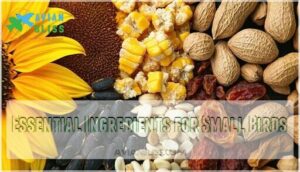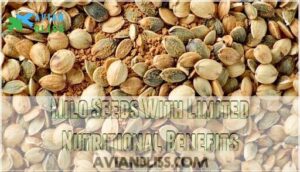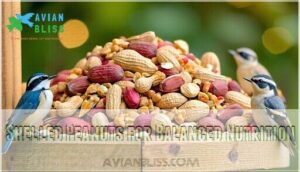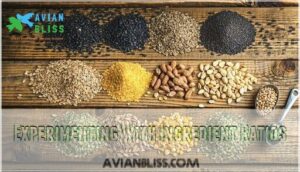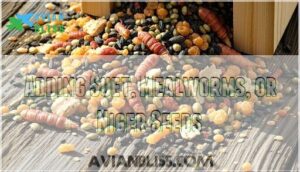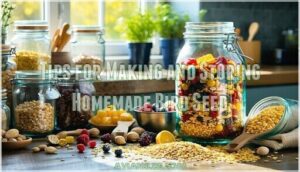This site is supported by our readers. We may earn a commission, at no cost to you, if you purchase through links.

You’ll want to add cracked corn for variety, safflower seeds to deter squirrels, and dried fruits for natural sugars.
Don’t forget crushed eggshells—they provide calcium for eggshell formation during breeding season.
Most backyard birds prefer different seeds, so a diverse mix guarantees you’ll attract various species to your yard.
The right combination isn’t just bird food—it’s your ticket to creating a bustling bird sanctuary right outside your window.
Table Of Contents
- Key Takeaways
- Essential Ingredients for Small Birds
- Ingredients to Avoid in Small Bird Mixes
- Nutritional Breakdown of Bird Seed Ingredients
- Customizing Your Small Bird Food Mix
- Tips for Making and Storing Homemade Bird Seed
- Providing a Balanced Diet for Small Birds
- Frequently Asked Questions (FAQs)
- How to make your own bird feed mix?
- What is the best seed mix for small birds?
- What are the ingredients in bird food?
- What are the ingredients in baby bird food?
- How do you make homemade bird food?
- Are there filler ingredients in homemade bird seed?
- How do you make homemade bird seed?
- Can birds eat seed mix?
- How do you make a homemade bird feeder?
- Are homemade bird seeds good for birds?
- Conclusion
Key Takeaways
- Use black oil sunflower seeds, white millet, and nyjer seeds as the core ingredients for balanced nutrition and high energy.
- Avoid fillers like milo, red millet, and grain sorghum—they provide little nutrition and attract pests.
- Add variety with cracked corn, safflower seeds, dried fruits, and crushed eggshells for calcium and broader species attraction.
- Keep your mix fresh and mold-free by using airtight containers and cleaning feeders regularly.
Essential Ingredients for Small Birds
You’ll need specific ingredients in your small bird food mix to guarantee proper nutrition and energy levels for your feathered visitors.
The right combination of black oil sunflower seeds, white millet, cracked corn, peanuts, and dried fruits provides the complete spectrum of proteins, fats, carbohydrates, and essential vitamins that small birds require for healthy growth and sustained activity, including complete nutrition and essential vitamins.
Black Oil Sunflower Seeds for High Energy
Black oil sunflower seeds power your backyard birds like nothing else in a small bird food mix.
I’ll create a short, engaging blockquote in the same tone as the paragraph about black oil sunflower seeds:
Black oil sunflower seeds: nature’s perfect energy package that keeps your feathered visitors coming back for more.
These energy-rich seeds contain the perfect balance of fats and proteins to fuel your feathered visitors throughout their busy days. You’ll notice birds prefer them over other options because of their thin shells, which even the smallest species can crack open easily.
The high oil content provides essential energy for flight, keeping warm in winter, and maintaining overall health. They’re cost-effective too—birds eat the entire seed, reducing waste under your feeder.
Store them in a cool, dry place to maintain their nutritional value and attract a variety of colorful birds to your yard.
White Millet for Digestion and Nutrition
Beyond sunflower seeds, white millet stands as another cornerstone in your small bird food mix.
This nutrient-dense grain offers several advantages for your feathered visitors:
- Contains 6.1 grams of protein per cup, supporting muscle development
- Provides 18% of daily magnesium needs, essential for bird health
- Offers multiple B vitamins including folate for metabolic functions
- Features natural fiber that aids digestion and improves stool frequency
- Remains gluten-free, making it suitable for birds with sensitivities
You’ll notice ground-feeding birds like sparrows and juncos especially appreciate this digestive aid.
Cracked Corn for Attracting Various Species
Cracked corn’s versatility makes it a valuable addition to your small bird seed mix. This affordable ingredient attracts an impressive variety of feathered visitors while providing essential energy through carbohydrates.
- Offers quick energy for birds during cold weather when calorie needs increase
- Attracts ground-feeding species like doves, juncos, and sparrows
- Serves as an economical filler that doesn’t sacrifice nutritional value
When adding cracked corn to your bird food ingredients, use moderation. Too much can spoil quickly in wet conditions and may attract unwanted wildlife beyond your target small bird species.
Peanuts as a Source of Protein and Oil
Including peanuts in your bird food mix provides essential protein and oil that birds need for energy and growth.
These nutritional powerhouses attract woodpeckers, jays, chickadees, and nuthatches to your yard.
Offer peanuts in different forms—whole, chopped, or shelled—depending on the birds you want to attract.
Chopped peanuts work best for smaller birds that can’t handle whole nuts.
Store peanuts safely in airtight containers to prevent mold growth.
While rich in nutrients, use peanuts sparingly as they can spoil quickly.
Remember it’s vital to address peanut shell concerns, as shells may create waste beneath feeders.
It’s essential to avoid salted varieties, as they can lead to salt toxicity in birds, which is a critical consideration for bird health.
Dried Fruits for Added Variety
While peanuts offer substantial protein, dried fruits bring essential vitamins to your small bird food mix.
Adding dried fruits provides:
- Natural energy from fruit sugars
- Additional hydration through moisture retention
- Essential vitamins not found in seeds
- Visual appeal that attracts more bird species
Soak raisins or cranberries overnight to prevent stomach swelling. Chop larger fruits like apricots into bird-safe sizes. Mix dried blueberries, cherries, and papaya with sunflower seeds and nuts for a balanced blend birds can’t resist, offering natural energy and visual appeal.
Ingredients to Avoid in Small Bird Mixes
You’ll want to avoid low-value fillers like milo, grain sorghum, and red millet in your small bird food mix as they provide minimal nutrition and often go uneaten.
These inferior ingredients waste your money as well as can attract unwanted pests like rodents while creating unnecessary mess around your feeding stations, which is a complete waste and can attract unwanted pests.
Grain Sorghum and Unwanted Creatures
While quality seeds attract your favorite songbirds, grain sorghum (milo) invites unwelcome dinner guests to your yard.
This common filler in cheap wild bird food mixes becomes a magnet for troublesome creatures.
Birds often reject milo, leaving it scattered below feeders where rodents keenly gather.
Research shows blackbirds may consume sorghum, perching on panicles and leaving broken seeds and droppings behind.
The scattered waste creates perfect conditions for bird food spoilage.
More concerning, sorghum attracts aphids that produce honeydew, drawing ants and other insects to your feeding station.
Many prefer sunflower seeds, a universal favorite for attracting birds.
For a cleaner, more effective feeding area that discourages rodents, replace wasteful birdseed containing sorghum with nutritional alternatives like black oil sunflower seeds or white millet.
Milo Seeds With Low Nutritional Value
Milo seeds represent the ultimate bird food disappointment.
These round, brownish grains might bulk up commercial seed mixes, but they offer minimal nutritional value with primarily carbohydrates and little fat—precisely what birds don’t need.
When you include these filler seeds in your feeders, you’ll notice most birds actively reject them, pushing them aside to reach more nutritious options.
This bird rejection creates unnecessary waste beneath your feeders.
For better cost-benefit analysis, replace milo with black oil sunflower seeds, which provide essential fats and proteins.
The slight increase in bird food quality and cost is worth it when you see birds actually eating what you provide rather than scattering unwanted milo across your yard, which is the ultimate bird food disappointment with minimal nutritional value and primarily carbohydrates, offering little benefit with unnecessary waste.
Red Millet and The Mess It Creates
Red millet creates significant waste in your bird seed mixes.
When included, most backyard birds reject it, scattering these unwanted seeds beneath feeders.
- Creates unsightly piles of discarded seeds under feeders
- Attracts unwanted pests like rodents and insects
- Reduces cost-effectiveness of your bird food purchases
- Indicates lower quality in commercial bird seed mixes
While red millet is often used as a filler in cheap bird seed mixes, most songbirds prefer white millet instead.
By avoiding red millet, you’ll save money and keep your feeding area cleaner.
Nutritional Breakdown of Bird Seed Ingredients
You’ll find each bird seed type offers distinct nutritional benefits that support your feathered visitors in different ways.
Understanding these nutrients helps you create a more effective food mix that meets small birds’ specific dietary needs throughout changing seasons, which is crucial for supporting your feathered visitors.
Sunflower Seeds for Balanced Nutrition
Unlike low-value fillers, sunflower seeds stand as nutritional powerhouses in your bird food mix.
Black oil varieties contain 40-50% fat, providing essential energy birds need daily. You’ll notice they’re the first seeds to disappear from feeders!
When preparing your mix, aim for 30-40% sunflower content to address birds’ nutritional needs.
Store them properly to prevent spoilage – airtight containers work best. Both striped and black oil varieties work well, though smaller birds prefer the thinner shells of black oil seeds, which are a key part of a bird’s daily energy needs.
Milo Seeds With Limited Nutritional Benefits
Moving from sunflower’s nutritional powerhouse, let’s examine milo seeds – often the least valuable component in your bird food mix.
Milo seeds offer minimal nutritional benefits with just 94 calories per ounce, primarily from carbohydrates with very little fat content. Many backyard birds actually reject these seeds, creating unnecessary waste.
This bird food filler is particularly unpopular among Eastern species, though some Southwestern birds will consume it. To improve bird health, consider that fiber supports digestion.
When analyzing the cost-benefit analysis of your bird seed ingredients, replacing milo with more nutritious options reduces waste and better supports your feathered visitors’ dietary needs.
Millet Seeds and Their Antioxidant Properties
Packed with powerful properties, millet seeds serve as antioxidant powerhouses in your small bird food mix. These tiny nutritional gems protect your feathered friends from harmful free radicals while supporting overall health.
When you include millet seeds in your bird food, you’re providing:
- Natural antioxidants like phenolic acids and flavonoids that combat cellular damage
- Immune system boosters that help birds resist disease
- Anti-inflammatory compounds that support joint health and mobility
White millet especially aids digestion while delivering essential minerals that keep your backyard visitors thriving and active, making it a great source of natural antioxidants and immune system boosters that support the overall health of your birds.
Hemp Seeds for High Fat and Protein Content
While millet seeds offer antioxidant benefits, hemp seeds stand as nutritional powerhouses in your bird food mix.
These small seeds deliver an impressive combination of fats and proteins that wild birds need, especially during high-energy seasons.
Hemp seeds contain about 30-35% fat and 25% protein, making them perfect for birds’ dietary needs.
Your backyard visitors will benefit from hemp seeds’ rich vitamin profile—including B1, B6, and B9—along with essential minerals like copper and magnesium.
For ideal ratios in seed combinations, mix one part hemp seeds with five parts other ingredients.
Many bird enthusiasts notice certain species show strong hemp seed preferences.
Finches, chickadees, and cardinals particularly enjoy these nutritious morsels.
When planning your storage solutions, keep hemp seeds in airtight containers to maintain their freshness and nutritional integrity.
Shelled Peanuts for Balanced Nutrition
Shelled peanuts serve as nature’s power bars in your bird food mix, offering a complete nutritional package that small birds love.
While hemp seeds deliver specific benefits, peanuts provide overall balanced nutrition. You’ll find these protein-packed morsels attract a variety of backyard visitors:
- Each ounce contains about 567 calories from peanut oil and peanut protein
- They offer 25% protein content for muscle development and feather health
- Peanut variety matters – always choose unsalted, raw options
- Proper peanut storage in cool, dry containers prevents harmful mold
- Birds can digest both whole and chopped versions depending on species
The natural fats in shelled peanuts help birds maintain energy reserves, especially during cold months when they need extra calories. For a balanced diet for birds, include peanuts as 10-15% of your mix. They’re particularly favored by woodpeckers, chickadees, and nuthatches who appreciate bird food fats for sustained energy.
Customizing Your Small Bird Food Mix
You can create the perfect meal for your backyard visitors by adjusting seed ratios based on which birds frequent your yard.
You’ll discover that adding specialty items like niger seeds or mealworms attracts specific species while enhancing the nutritional value of your custom mix.
Experimenting With Ingredient Ratios
Now that you understand the nutritional value of each ingredient, it’s time to perfect your bird seed ratios.
Start with a basic 3:2:1 formula (three parts sunflower seeds, two parts millet, one part cracked corn) and adjust based on your visitors’ preferences.
Watch which seeds disappear fastest—birds vote with their beaks! Northern birds typically prefer higher calorie density during winter, while summer blends can include more variety.
Consider seasonal changes and cost effectiveness when experimenting with your bird food blend ratio, as small adjustments can dramatically impact which species visit your feeders.
Adding Suet, Mealworms, or Niger Seeds
Now that you’ve found your ideal seed ratios, consider these power-packed additions to your small bird food mix:
Suet offers exceptional nutritional value with concentrated fats that give birds energy, especially in winter.
You can find various suet products for different bird types.
Over 54% of bird enthusiasts include it in their feeding stations.
Mealworms provide a protein source that chickadees prefer over thistle seeds.
They’re perfect for feeding injured birds too.
Niger seeds benefit goldfinches and siskins particularly.
About 62% of backyard birders offer these tiny black seeds, though they require proper storage to maintain freshness.
Creating New Shapes With Gelatin and Water
Beyond adding mealworms or nyjer seeds, you can create fun shapes with gelatin to make bird feeding more exciting.
Mix unflavored gelatin with water and your seed blend for moldable bird food that helps prevent mold. The gelatin properties provide excellent shape stability while keeping seeds fresh longer.
Try these simple molding techniques:
- Pour mixture into cookie cutters for themed shapes
- Use plastic lids to create perfect discs
- Layer different seed types for texture variations
- Add natural food coloring for visual appeal
Kids love helping make these bird food fun shapes!
Tips for Making and Storing Homemade Bird Seed
You’ll extend the shelf life of your homemade bird seed mix by storing it in airtight containers kept in cool, dry places away from direct sunlight.
When you make your own mix, choose fresh ingredients and measure precise ratios of sunflower seeds, millet, and nuts to create nutritionally balanced blends that small birds will enthusiastically visit your feeders to enjoy.
Stocking Up on Essential Ingredients
Regularly stocking up on essential ingredients guarantees your small birds always have nutritious food available. Smart bulk buying strategies can substantially reduce your seed costs while maintaining quality.
- Search local farm supply stores for discounted bulk nyjer seed and canary seed blends
- Join bird enthusiasts’ groups online to share bulk purchases of premium finch food mix
- Monitor seasonal sales on quality seed mix ingredients, particularly after winter months
Consider purchasing economical birdseed options to maximize your savings. Store your bulk purchases in airtight containers away from moisture and pests. This preserves the nutritional value while stretching your bird feeding budget throughout the year.
Proper Storage for Freshness and Nutrition
With your bird seed ingredients ready, proper storage becomes your next priority. Store your bird food mix in airtight containers to maintain freshness and nutritional value.
Glass jars or food-grade plastic containers work perfectly for keeping humidity and pests at bay. For reliable seed protection, consider dedicated containers.
Place these containers in a cool, dry location where temperature stays consistent—excessive heat can degrade nutritional quality.
For longer shelf life, refrigerate high-fat ingredients like peanuts and sunflower seeds. Label each container with the date to track freshness and use the oldest mixes first.
Avoiding Mold and Mildew in Feeders
Once you’ve mastered storing your bird seed properly, keeping feeders clean is your next challenge. Mold and mildew can quickly turn a bird’s dining spot into a health hazard.
To maintain mold-free feeders:
- Choose feeders with proper drainage holes to prevent water accumulation
- Place feeders in sunny spots with good air circulation to reduce moisture
- Clean feeders weekly with a 9:1 water-to-vinegar solution
- Select feeders made of non-porous materials like metal or UV-resistant plastic
- Use weather guards to protect food from rain and snow
Don’t overlook Material Choice when purchasing feeders. Some plastics trap moisture while copper or steel options resist contamination. Remember, Bird Health depends on your diligence – a clean feeder today means happy visitors tomorrow.
Your backyard birds can’t wipe down their own tables! Understanding the importance of proper birdseed storage and using homemade birdseed recipes can help create a safe environment for the birds. This is crucial for maintaining happy visitors and ensuring the well-being of the birds in your care.
Providing a Balanced Diet for Small Birds
You’ll create a healthier backyard ecosystem when you provide small birds with a balanced mix of seeds, nuts, and fruits that meet their specific nutritional needs.
Your feathered visitors need proper amounts of protein, carbohydrates, and fats to maintain their energy levels and support their overall health throughout changing seasons, which is crucial for a healthier backyard ecosystem.
Offering Variety With Feeders and Baths
After perfecting your seed storage routine, it’s time to set up your yard’s bird restaurant. Different feeder types attract unique diners to your bird food mix buffet.
| Feeder Type | Best For | Bird Seed Varieties | Placement Strategy | Seasonal Changes |
|---|---|---|---|---|
| Platform | Juncos, Doves | Millet, cracked corn | Low, open areas | Add cover in winter |
| Tube | Finches, Chickadees | Sunflower, nyjer | Near shrubs, 5-6 ft high | More in migration seasons |
| Hopper | Cardinals, Jays | Mixed seed recipes | 5-6 feet high, sheltered | Weather protection in rain |
| Suet | Woodpeckers | Fat-based mixes | On tree trunks | More in cold months |
| Bird Bath | All species | N/A | Shallow, shaded spots | Heated in winter |
Water sources are just as important as your bird seed types—birds need both! They require a combination of food and water to thrive, making your yard a complete habitat for them. Providing the right feeder types and water sources can attract a variety of bird species, enhancing your yard’s biodiversity and making it a welcoming environment for birds.
Keeping Feeders Clean and Well-Maintained
Keeping your feeders in top shape guarantees birds get the nutrition they need without harmful bacteria. Clean feeders mean healthy birds.
- Clean weekly with hot soapy water and rinse thoroughly
- Sanitize monthly using a 1:9 bleach-to-water solution
- Replace wet seed immediately to prevent mold growth
- Check feeding ports for blockages that trap moisture
Different feeder materials need different care – plastic can be dishwasher-safe while wooden feeders need gentle hand washing. Your tidy feast will deter pests and keep your backyard birds coming back for more.
Observing Bird Preferences for Optimal Nutrition
Now that your feeders are clean, watch closely to determine what your backyard visitors actually prefer.
By observing feeding behavior, you’ll understand which bird food ingredients best meet their nutritional needs. Supplying high-fat feeds is especially beneficial for birds preparing for fall migration and winter survival.
| Species | Seed Choice | Feeding Style | Peak Times | Nutritional Needs |
|---|---|---|---|---|
| Finches | Nyjer, sunflower | Social, lengthy | Morning | High fat, protein |
| Sparrows | White millet | Ground feeding | All day | Varied diet |
| Chickadees | Black oil sunflower | Quick visits | Early morning | High energy |
| Cardinals | Safflower | Cautious approach | Dawn/dusk | Year-round protein |
| Woodpeckers | Peanuts, suet | Deliberate pecking | Midday | High fat content |
This bird food detective work reduces waste while ensuring small birds get ideal nutrition through seasonal variation in their diet.
Frequently Asked Questions (FAQs)
How to make your own bird feed mix?
Mix 3 parts black oil sunflower seeds, 2 parts safflower, 1 part white millet, and 1 part peanuts. You’ll save money and birds will flock to your yard for this nutritious blend.
What is the best seed mix for small birds?
The best seed mix for small birds includes black oil sunflower seeds, white millet, and nyjer seeds.
Add cracked corn and safflower sparingly for variety.
This mix offers balanced nutrition, energy, and easy feeding for small birds.
What are the ingredients in bird food?
Bird food typically includes sunflower seeds, safflower seeds, nyjer, millet, cracked corn, peanuts, dried fruits, suet, and grains like oats.
Each ingredient offers birds energy, protein, and essential nutrients for their health and well-being.
What are the ingredients in baby bird food?
You’ll need a mix of soaked dog kibble, hard-boiled egg yolk, and mealworms for baby birds.
Blend well to a paste-like consistency.
Avoid milk, bread, or seeds since they can harm baby birds.
How do you make homemade bird food?
Picture a cold morning and hungry birds outside.
Combine black oil sunflower seeds, safflower seeds, white millet, chopped peanuts, and dried fruit.
Stir well.
Serve fresh in a clean feeder.
Birds will happily flock!
Are there filler ingredients in homemade bird seed?
Yes, homemade bird seed can have fillers like red millet, wheat, or milo.
Birds often skip these, creating waste.
Stick to nutrient-rich options like sunflower, nyjer, safflower seeds, and peanuts for better results.
How do you make homemade bird seed?
Mix 3 parts sunflower seeds, 2 parts safflower, 2 parts nyjer, 1 part white millet, and 1 part peanuts. Avoid fillers like red millet. Store in an airtight container to keep it fresh.
Can birds eat seed mix?
Birds can eat seed mixes as long as they’re made with quality ingredients like sunflower, safflower, millet, and nyjer.
Avoid fillers like red millet or milo since they offer little nutrition and create waste.
How do you make a homemade bird feeder?
It’s amazing how simple it is!
Use a clean milk carton, cut large openings for access, and hang it securely.
Add perches with pencils or sticks.
Fill it with seed, inviting birds instantly!
Are homemade bird seeds good for birds?
Making your own bird seed can be great for birds if you use high-quality ingredients like sunflower seeds, nyjer, or millet.
Avoid fillers like milo or red millet that add little nutrition and attract pests.
Conclusion
A well-crafted small bird food mix ingredients list is your ace in the hole for attracting vibrant bird species.
Use black oil sunflower seeds for energy, white millet for nutrients, and dried fruits for sugar.
Add safflower seeds or cracked corn for variety, and don’t skip crushed eggshells for calcium.
Avoid fillers like milo or red millet.
By offering fresh, balanced options, you’ll create a thriving sanctuary where small birds can flourish in your backyard.
- https://www.tandfonline.com/doi/full/10.1080/00063657.2017.1311836
- https://avianres.biomedcentral.com/articles/10.1186/s40657-018-0111-z
- https://www.purchase.edu/live/files/2329-vanhouten-and-yates-2018pdf
- https://besjournals.onlinelibrary.wiley.com/doi/full/10.1111/1365-2435.14164
- https://www.cam.ac.uk/research/news/watching-tv-helps-birds-make-better-food-choices

